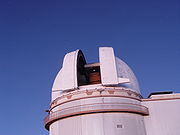
UH88
Encyclopedia

Mauna Kea Observatory
The Observatories at Mauna Kea, , are an independent collection of astronomical research facilities located on the summit of Mauna Kea on the Big Island of Hawai'i, USA. The facilities are located in a special land use zone known as the "Astronomy Precinct," which is located in the Mauna Kea...
and operated by the University's Institute for Astronomy
Institute for Astronomy
The Institute for Astronomy is a research unit within the University of Hawaii system, led by Günther Hasinger as Director. IfA main headquarters are located at 2680 Woodlawn Drive in Honolulu, Hawaii, , on the University of Hawaii at Mānoa campus. Additional facilities are located at Pukalani,...
. It was constructed in 1968, and entered service in 1970, at which point it was known as "The Mauna Kea Observatory." It became the first professional telescope to be controlled by computer. The telescope was built with funding from NASA, to support Solar System
Solar System
The Solar System consists of the Sun and the astronomical objects gravitationally bound in orbit around it, all of which formed from the collapse of a giant molecular cloud approximately 4.6 billion years ago. The vast majority of the system's mass is in the Sun...
missions and is controlled by the University of Hawai'i. The success of the telescope helped demonstrate the value of mountain for astronomical observations.
On December 4, 1984 it became the first telescope to make optical closure phase
Closure phase
The closure phase is an observable quantity in imaging astronomical interferometry, which allowed the use of interferometry with very long baselines. It forms the basis of the self-calibration approach to interferometric imaging...
measurements on an astronomical source using an aperture mask
Aperture masking interferometry
Aperture Masking Interferometry is a form of speckle interferometry, allowing diffraction limited imaging from ground-based telescopes. This technique allows ground based telescopes to reach the maximum possible resolution, allowing ground-based telescopes with large diameters to produce far...
.
UH88 is a Cassegrain reflector
Cassegrain reflector
The Cassegrain reflector is a combination of a primary concave mirror and a secondary convex mirror, often used in optical telescopes and radio antennas....
tube telescope with an f/10 focal ratio, supported by a large open fork equatorial mount
Equatorial mount
An equatorial mount is a mount for instruments that follows the rotation of the sky by having one rotational axis parallel to the Earth's axis of rotation. This type of mount is used for astronomical telescopes and cameras...
. It was the last telescope on Mauna Kea to use a tube design rather than an open truss, and is the largest in the complex to use an open fork mount, with neighboring telescopes in the 3-meter class using English fork designs.
As the only research telescope controlled solely by the University, UH88 has long been the primary telescope used by its professors, postdoctoral scholars and graduate students, and as a result, the site of numerous discoveries. David C. Jewitt
David C. Jewitt
David C. Jewitt is a professor of astronomy formerly at the University of Hawaii Institute for Astronomy, now at UCLA. He was born in 1958 in England, and is a 1979 graduate of the University of London. Jewitt received an M.Sc. and a Ph.D. in astronomy at the California Institute of Technology in...
and Jane X. Luu discovered the first Kuiper belt
Kuiper belt
The Kuiper belt , sometimes called the Edgeworth–Kuiper belt, is a region of the Solar System beyond the planets extending from the orbit of Neptune to approximately 50 AU from the Sun. It is similar to the asteroid belt, although it is far larger—20 times as wide and 20 to 200 times as massive...
object, 1992 QB1 using UH88, and a team led by Jewitt and Scott S. Sheppard
Scott S. Sheppard
Scott S. Sheppard is an astronomer in the Department of Terrestrial Magnetism at the Carnegie Institution for Science. Starting as a graduate student at the Institute for Astronomy at the University of Hawaii, he was credited with the discovery of many small moons of Jupiter, Saturn, Uranus, and...
discovered 45 of the known moons of Jupiter, as well as moons of Saturn, Uranus and Neptune.
The Institute for Astronomy also makes agreements with other organizations for portions of available observing time. Currently, the National Astronomical Observatory of Japan
National Astronomical Observatory of Japan
The is an astronomical research organisation comprising several facilities in Japan, as well as an observatory in Hawaii. It was established in 1988 as an amalgamation of three existing research organizations - the Tokyo Astronomical Observatory of the University of Tokyo, International Latitude...
uses UH88 for some research projects for which its far larger and more expensive Subaru Observatory
Subaru (telescope)
Subaru Telescope is the 8.2 metre flagship telescope of the National Astronomical Observatory of Japan, located at the Mauna Kea Observatory on Hawaii. It is named after the open star cluster known in English as the Pleiades...
, also on Mauna Kea, would be overkill. The Nearby Supernova Factory
Nearby Supernova Factory
The Nearby Supernova Factory is a collaborative experiment led by Greg Aldering, designed to collect data on more Type Ia supernovae than have ever been studied in a single project before, and by studying them, to increase understanding of the expanding universe and "Dark Energy."The project began...
project, based at Lawrence Berkeley National Laboratory, also has its Supernova Integrated Field Spectrograph (SNIFS) instrument mounted on UH88.
In June 2011, the telescope and its weather station were struck by lightning, damaging many systems and disabling it, but the telescope was repaired by August 2011 Some the systems at the observatory, 41 years old at the time of the damage, had to be reverse engineering
Reverse engineering
Reverse engineering is the process of discovering the technological principles of a device, object, or system through analysis of its structure, function, and operation...
to be fixed.

